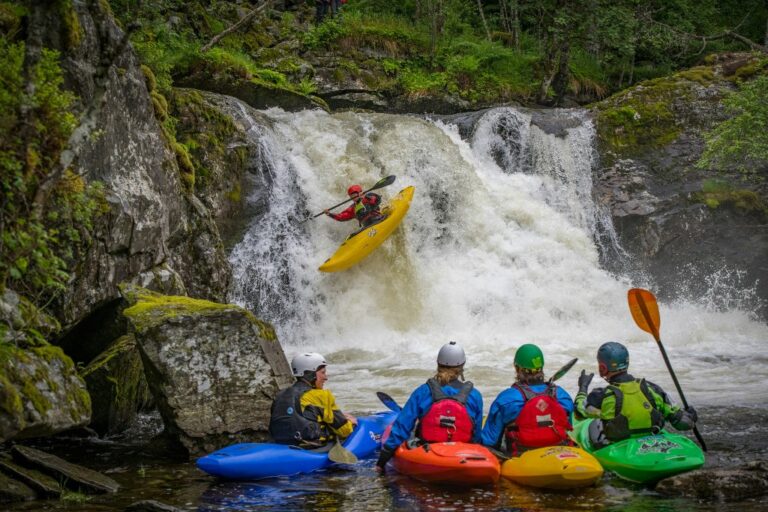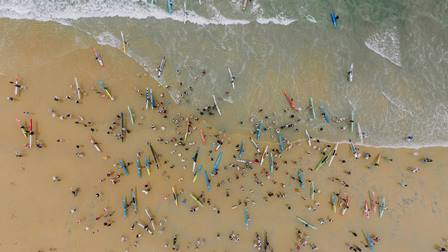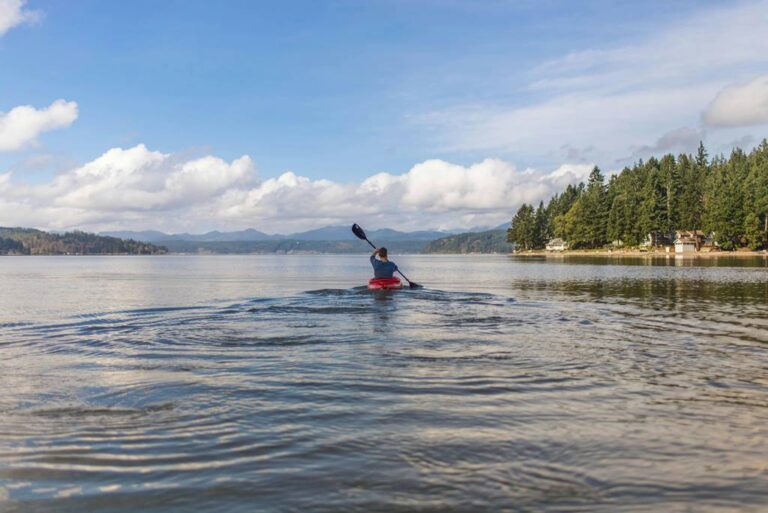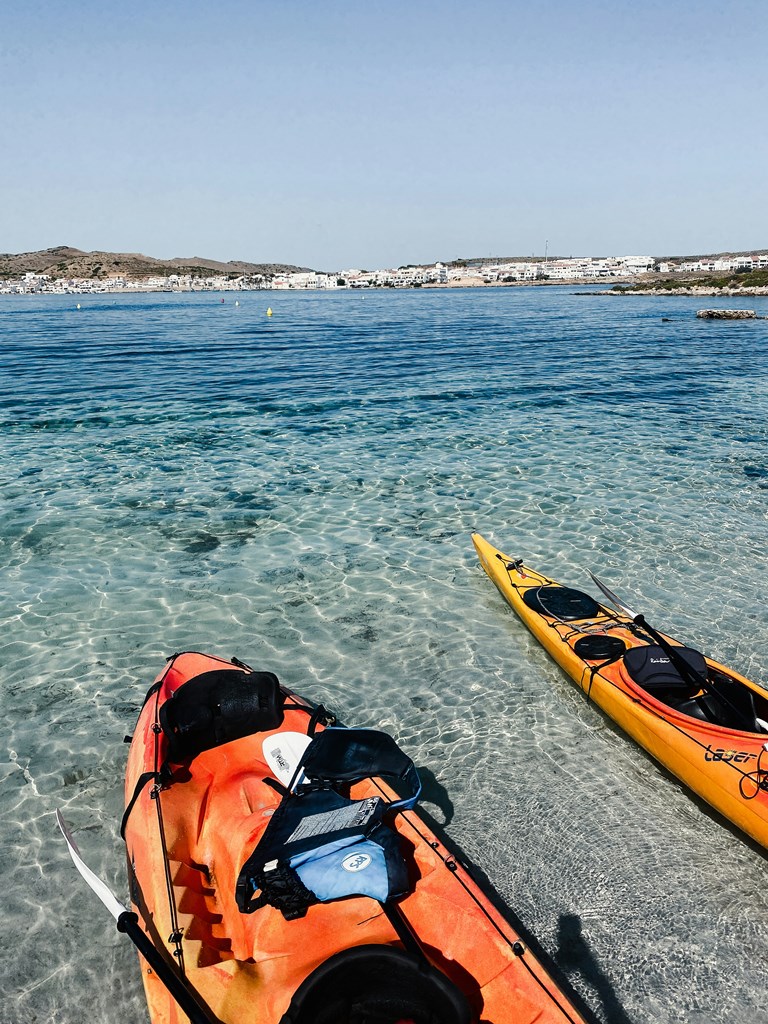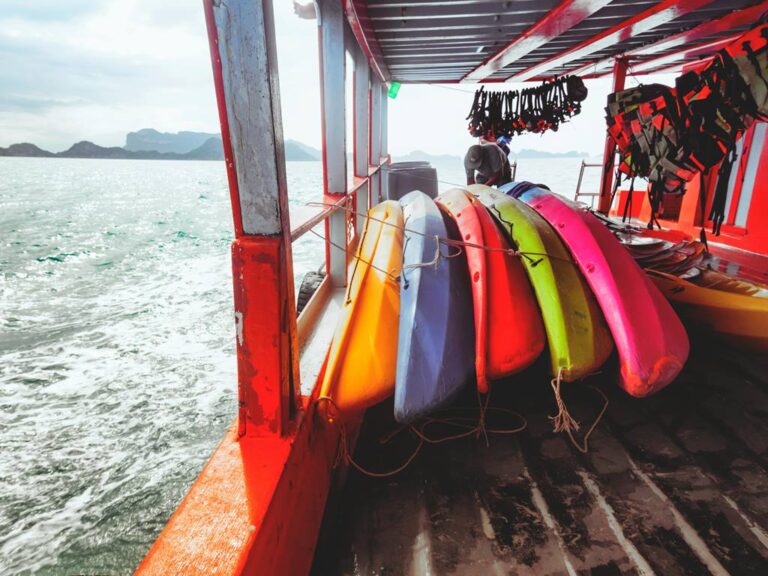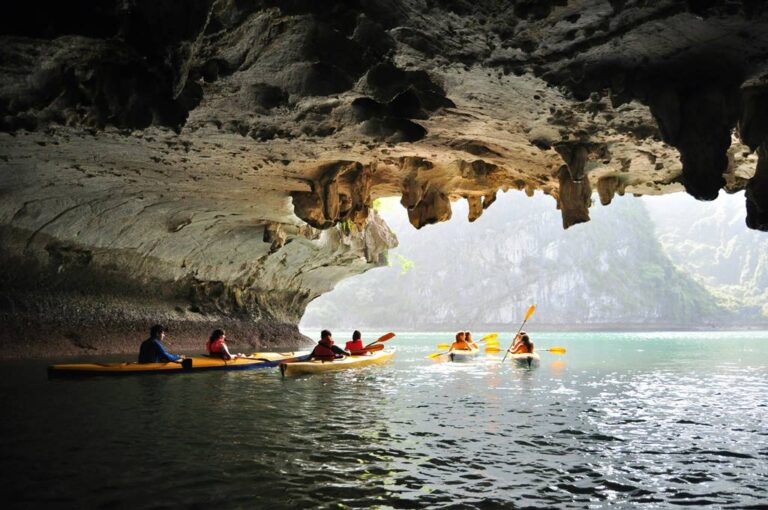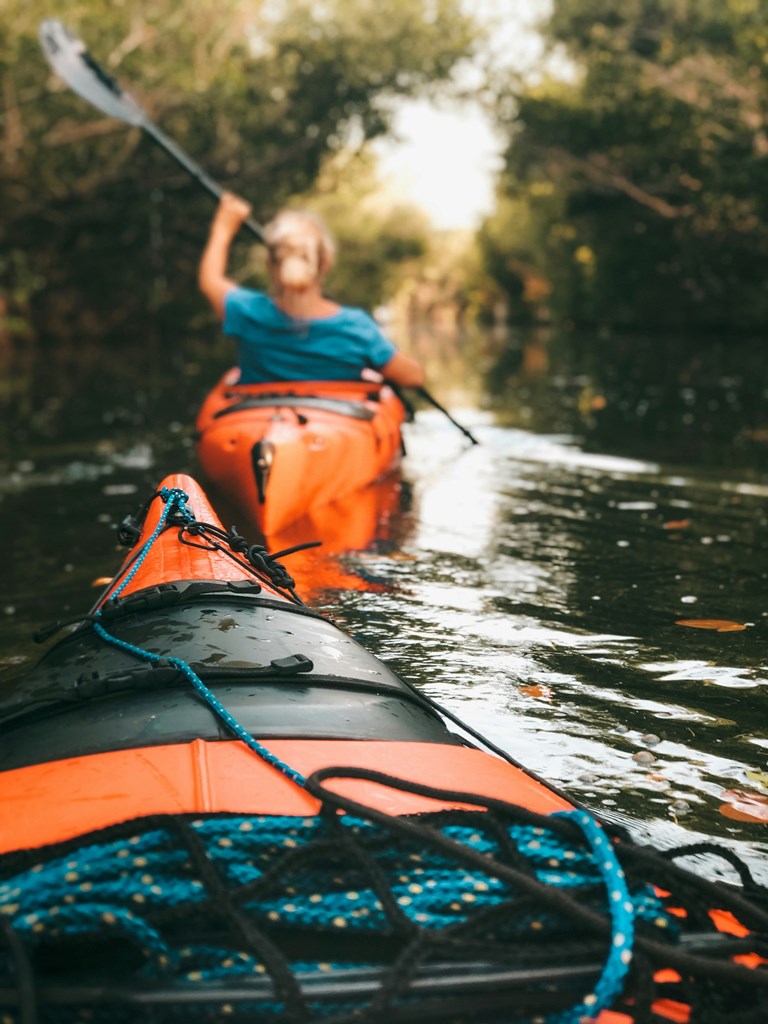
Table of Contents
Choosing suitable kayaking clothes might seem daunting at first, but it shares some similarities with picking outfits for other outdoor activities like hiking. You’ll need kayak wear that’s versatile, durable, and comfortable for paddling for extended periods. However, unlike hiking where you might only encounter occasional splashes, kayaking throws in the possibility of getting completely soaked. So, protection from the elements becomes crucial.
Choosing the Perfect Kayak Outfit
When it comes to what to wear kayaking, safety and comfort are top priorities. Here’s a breakdown of essential considerations:
- Life Jacket First: Always wear a Personal Flotation Device (PFD) and keep it on throughout your trip. If you need to adjust layers, find a safe spot to land before making changes. Consider “rafting up” with a friend momentarily for extra stability, but ideally, change on dry land.
- Dress for the Water: Water temperature is key, not air temperature. You might need a wetsuit or even a dry suit for colder conditions.
- Layering Up: Dressing in layers, especially on top, allows you to adapt to changing weather.
- Sun Protection is Essential: Sun exposure is real, even on cloudy days. Look for kayak outfits made with UPF-rated fabrics and don’t forget sunscreen for extra protection against reflected UV rays.
- Quick-Drying Fabrics are Key: Avoid cotton like the plague. It absorbs water and stays wet. Instead, opt for quick-drying synthetics like nylon or polyester. Wool is another option, but it dries slower – though it does insulate even when wet.
- Comfort and Movement: Choose clothes that allow for comfortable paddling motions and sitting for extended periods.
- Abrasion Resistance Matters: Expect some wear and tear from sand, water, and your kayak itself. Opt for abrasion-resistant fabrics built to handle these conditions.
- Ditch the Rust: Freshwater or saltwater can corrode metal zippers, fasteners, and hardware. Look for rugged plastics or trust corrosion-resistant components in specialized paddling gear.
Dressing for a Delightful Kayak Adventure in Mild Conditions

Choosing the right kayak attire for mild conditions is crucial for a comfortable and enjoyable paddling experience. Here’s a breakdown of what to wear:
Underwear:
- For warm weather and shorter trips, many people opt for a swimsuit as a base layer. Just ensure it’s comfortable for the duration of your paddle (avoid cotton!).
- Alternatively, choose non-cotton sports bras and underwear designed for outdoor activities.
Tops:
- Rashguards: Made from quick-drying, stretchy polyester or nylon with Lycra® spandex, these offer excellent sun protection (UPF) and comfort when paddling or layering under other clothing/wetsuits.
- Water Shirts: These looser-fitting options also offer UPF protection but are better suited for sun protection and not swimming.
Bottoms:
- Board Shorts or Quick-Dry Pants: Comfort and quick-drying are key! Avoid anything that restricts movement or causes chafing. Super thin fabrics are not ideal for constant paddling.
Mid-Layer (Optional):
- If a wetsuit or drysuit isn’t necessary, consider bringing a warm, synthetic fleece jacket for added warmth.
Outer Layer (Optional – Rain/Wind):
- Waterproof/Breathable Jacket & Rain Pants: Protect yourself from significant rain or wind with high-quality breathable gear. Paddling jackets with wrist and neck closures are particularly effective against drips from your paddle.
- Water-Resistant Jacket: For short outings with minimal rain, a water-resistant jacket can suffice.
Footwear:
- Neoprene Paddling Booties: Ideal for their lightweight, water-ready design that protects your toes and feet.
- Alternatives: Any closed-toe footwear offering similar protection works. Avoid water sandals (less protective) and flip-flops (can come off easily).
- Cold/Wet Conditions: Consider waterproof socks, thicker non-cotton socks for extra warmth, or waterproof booties. Pogies (gloves attached to the paddle) are another option for cold days.
Sun Protection:
- Hat: Opt for a wide-brimmed hat and consider a leash to secure it. For colder weather, add a beanie that fits well under your main hat.
Hand Protection (Optional):
- Paddling Gloves: Protect your hands from blisters and cold.
- Pogies: Ideal for cold days, these keep your hands warm while allowing a direct grip on the paddle shaft.
Glasses Retainer:
- A floating retainer is essential to prevent losing your sunglasses overboard. Consider bringing a spare retainer as well.
Personal Flotation Device (PFD):
- Always wear a properly fitted PFD, regardless of distance from shore. PFDs provide core body warmth and keep you afloat in case of a capsize.
By following these tips, you can choose the perfect kayaking wear for a comfortable and safe adventure on the water!
Staying Warm and Safe in Cool or Cold Water While Kayaking
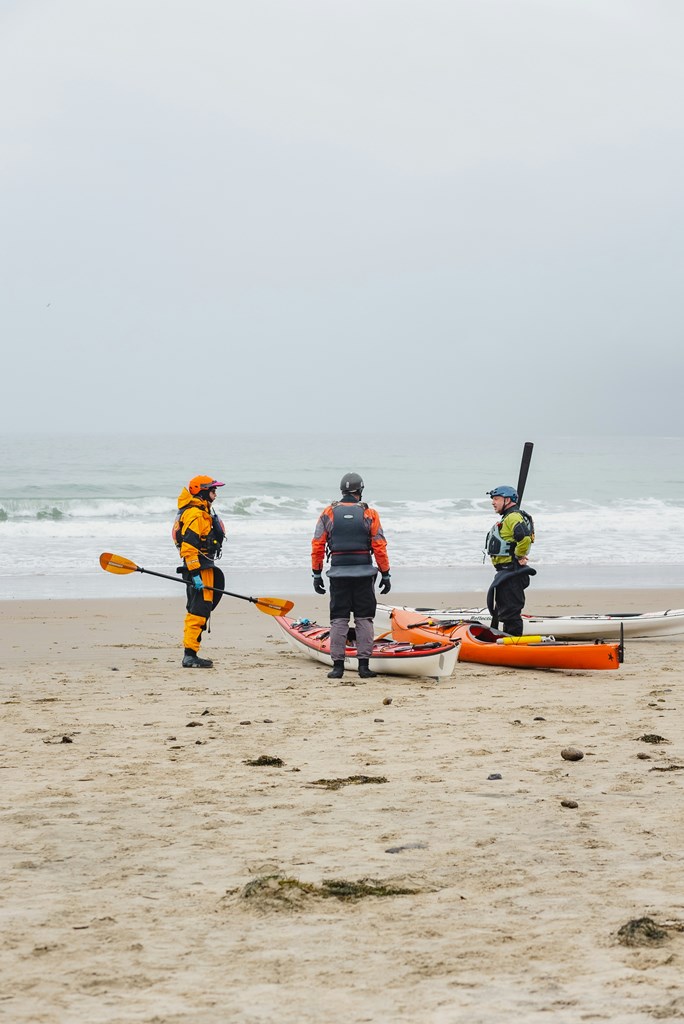
Choosing the right kayaking attire for cool or cold water is crucial for a safe and enjoyable experience. Here’s what to consider when dressing for a kayak trip:
Dress for Immersion, Not Just the Trip:
Unlike calm scenarios, prioritize clothing for potential capsizing. Imagine yourself falling in; what would keep you warm? This mindset is key, whether it’s your first paddle or your hundredth.
The Dangers of Cold Water Immersion:
Cold water can cause immediate shock to your lungs and heart, increasing the risk of drowning. It can also lead to hypothermia if you’re not properly insulated. Remember, after a capsize, putting on a wetsuit becomes difficult, if not impossible.
How Cold is “Cold” Water?
The U.S. Coast Guard advises caution as cold-water immersion effects can occur in water as warm as 70°F (21°C).
Wetsuits vs. Drysuits:
Unless you’re paddling in very calm, protected waters with mild temperatures, a wetsuit or dry suit is highly recommended. Here’s a breakdown of these options for kayak wear:
- Wetsuits: The minimum protection for cool or cold water. Made of thick neoprene, they trap a thin layer of your body-warmed water next to your skin for insulation.
- Drysuits: Designed for colder water and air temperatures. These waterproof suits with watertight seals keep you completely dry. Adjust your warmth by layering clothes underneath.
Hot Air, Cold Water:
Even with hot air, cold water necessitates a wetsuit. You might be a bit warm while paddling, but you’ll be comfortable and safe if you end up in the water.
Finding Water Temperatures:
- Coastal Waters: Check the National Oceanic and Atmospheric Administration (NOAA) water temperature map for coastal areas.
- Inland Waters: Search online, ask your guide, or contact a local paddling club or shop for water temperature information in inland areas or locations not covered by NOAA. Shop staff can also guide you in choosing the right wetsuit or dry suit for your needs.
By following these tips and choosing the appropriate kayaking outfit, you can ensure a warm, safe, and enjoyable kayaking experience in cooler or cold water conditions.
Layering Tips for Wearing a Wetsuit or Dry Suit
Layering is key to staying comfortable and warm in your kayak outfit, especially when using a wetsuit or dry suit. Here’s a breakdown of layering strategies for different scenarios:
Layering with a Long-Sleeve Wetsuit:
- Base Layer (Optional): The warm water trapped within your wetsuit eliminates the need for a wicking base layer. However, having a swimsuit underneath can be convenient for changing later without needing a private area.
- Mid Layer (Optional): The warmth of the trapped water and the wetsuit’s thickness provide insulation. Consider a thicker wetsuit for colder conditions.
- Outer Layer (Optional): While wetsuits are watertight, wind can cause them to lose heat if you get wet. Depending on the wetsuit’s thickness and weather conditions, a windproof outer layer may be necessary.
Layering with a Sleeveless or Short-Sleeve/Shorts Wetsuit:
- Base Layer: Since these wetsuits expose more skin, consider a quick-drying top underneath to cover your arms. A long-sleeve base layer or rashguard offers both warmth and sun protection. Opt for a slightly thicker wicking top if the air is cool. Remember, these wetsuits are best suited for mild conditions.
- Mid and Outer Layers: Pack a light fleece jacket along with a rain jacket or paddling jacket (to wear over the fleece) for additional warmth and wind protection if the weather turns colder and wetter.
Layering with a Drysuit:
- Base Layer: Think of a dry suit as waterproof rain gear with watertight seals. Non-cotton long underwear is essential underneath. You can also invest in drysuit liners, or some drysuits even come with a built-in fleece lining.
- Mid Layer (Optional): For extremely cold conditions, add a thick fleece layer over your long underwear for extra warmth.
- Outer Layer (Not Required): Drysuits are already windproof and waterproof/breathable, eliminating the need for an additional outer layer.
By following these tips, you can master the art of layering and ensure a comfortable and enjoyable kayaking experience regardless of the water temperature or chosen wetsuit/drysuit.
Conclusion
Now that you’ve explored the key considerations for choosing and layering your kayaking attire, you’re well-prepared to navigate the water in comfort and confidence! Remember, safety is always paramount. So, prioritize a properly fitted PFD, check weather and water conditions before you head out, and don’t hesitate to adjust your layering based on the specific environment. With the right clothing choices and a little planning, you can ensure your kayaking adventure is as fun and fulfilling as it is safe.

